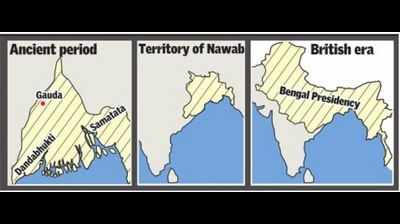- News
- City News
- kolkata News
- Historians trace `Banga' metamorphosis through the ages
Trending
This story is from August 3, 2016
Historians trace `Banga' metamorphosis through the ages

KOLKATA: Will it be Banga or Bangla? The verdict is not out yet but historians feel the former fits the bill perfectly as the name is integral to the state's history. Vouching for the antiquity of the name, they argued that `Banga' appears in the earliest written records -in the Mahabharata.
Sanskrit scholar and historian Nrisingha Prasad Bhaduri zeroed in on the story where Draupadi's Swayamvar is being held and Raja Samudrasen of Banga is one of the suitors.“That is perhaps the first time that any text has accepted Banga as an administrative or political territorry,“ said Bhaduri.
After researching on the word `Banga', philologists have come to the conclusion that the etymology of the name leads to a branch of a Dravidian tribe that was called Bong.Around 1000 BC, they settled in the Gangetic plains of what is known as Bengal today .
Though the word `Bangla' was first used in written records in the 14th century after the Sultanate of Bengal was established, Asiatic Society scholars pointed out that 11thcen tury South Indian records show that the term Bangaladesa have been used. “Of course at that time no one thought that one day a whole new nation, Bangladesh, would come into being,“ said Ramkrishna Chatterjee, historian of the Asiatic Society. When Shamsuddin Ilyas became the first sultan of the Bengal Sulta nate, he was called the Shah of Bangala. Even Portugese texts referred to the region as Bengala.
In 1352, we get the first shape of an inde pendent Bengal under Illyas. In 1540, when Sher Shah was crowned, the capital of Banga was Gaur. “We get a feel of the Bengal that we see today from the 16th century after Bengal Subah was established by the Mughals. The 12 Bhuniyas and the Nawabs of Bengal emerged as strong politcal contenders and under them Bengal grew in prominence,“ said historian Subhas Chakraborty .Murshid Quli Khan took the Nawabi to a new height but everything changed when Sirajud-daula was vanquished in 1757 at the Battle of Plassey .
“The British consolidated their power between 1757 and 1765 as the Company rule began under the Bengal Presidency , thus heralding an era of supremacy . This continued till 1911when the capital was shifted. The Partition of Bengal in 1905 by Lord Curzon for the first time divided eastern and western parts of Bengal, perhaps a precursor to what was to happen finally ,“ Chakraborty added.
The next watershed was, of course, Independence and the final Partition in 1947 that created West Bengal as a separate socio-political entity for the first time.
Sanskrit scholar and historian Nrisingha Prasad Bhaduri zeroed in on the story where Draupadi's Swayamvar is being held and Raja Samudrasen of Banga is one of the suitors.“That is perhaps the first time that any text has accepted Banga as an administrative or political territorry,“ said Bhaduri.
After researching on the word `Banga', philologists have come to the conclusion that the etymology of the name leads to a branch of a Dravidian tribe that was called Bong.Around 1000 BC, they settled in the Gangetic plains of what is known as Bengal today .
Though the word `Bangla' was first used in written records in the 14th century after the Sultanate of Bengal was established, Asiatic Society scholars pointed out that 11thcen tury South Indian records show that the term Bangaladesa have been used. “Of course at that time no one thought that one day a whole new nation, Bangladesh, would come into being,“ said Ramkrishna Chatterjee, historian of the Asiatic Society. When Shamsuddin Ilyas became the first sultan of the Bengal Sulta nate, he was called the Shah of Bangala. Even Portugese texts referred to the region as Bengala.
However, it is not necessary that the entire territory that we know as West Bengal today was Banga of the ancient times. Banga actually co-existed with other regions like Varendra, Suhma, Anga, Samatata and Harikela. Later, regions like Gauda and Pundravardhan were also added to this conglomerate. The influence of this area spread far and wide, even up to Sri Lanka, whose first ruler Vijaya was a Bengali.
In 1352, we get the first shape of an inde pendent Bengal under Illyas. In 1540, when Sher Shah was crowned, the capital of Banga was Gaur. “We get a feel of the Bengal that we see today from the 16th century after Bengal Subah was established by the Mughals. The 12 Bhuniyas and the Nawabs of Bengal emerged as strong politcal contenders and under them Bengal grew in prominence,“ said historian Subhas Chakraborty .Murshid Quli Khan took the Nawabi to a new height but everything changed when Sirajud-daula was vanquished in 1757 at the Battle of Plassey .
“The British consolidated their power between 1757 and 1765 as the Company rule began under the Bengal Presidency , thus heralding an era of supremacy . This continued till 1911when the capital was shifted. The Partition of Bengal in 1905 by Lord Curzon for the first time divided eastern and western parts of Bengal, perhaps a precursor to what was to happen finally ,“ Chakraborty added.
The next watershed was, of course, Independence and the final Partition in 1947 that created West Bengal as a separate socio-political entity for the first time.
End of Article
FOLLOW US ON SOCIAL MEDIA










